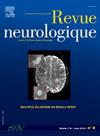Description of peripheral nervous system involvement in wild-type transthyretin amyloidosis: A clinical and electrophysiological study
IF 2.3
4区 医学
Q2 CLINICAL NEUROLOGY
引用次数: 0
Abstract
Introduction
Wild-type transthyretin amyloidosis (ATTRwt) is not clearly known to be associated with peripheral neurological complications. The aim of our study was to characterize neurological involvement in ATTRwt, as well as its evolution over time, using clinical and electrodiagnostic (EDX) data.
Methods
We prospectively included patients diagnosed with ATTRwt who were addressed by cardiologists. All patients underwent neurological evaluation, including examination (neuropathy impairment score) and an EDX study including electrochemical skin conductance and/or sympathetic skin response testing. Motor, sensory, and small fiber composite sum scores were calculated based on the EDX data. Clinical and EDX scores were then reassessed during the follow-up period.
Results
Fifty-two patients were included, 94% of whom were treated with tafamidis. At inclusion 98% of patients presented peripheral nerve involvement at EDX, the most common being carpal tunnel syndrome (88%), polyneuropathy (67%), and ulnar tunnel syndrome (21%). Twenty-nine patients were reevaluated and mean follow-up was 16.7 months with no significant change of clinical or neurophysiological data.
Discussion
In our cohort, a large majority of ATTRwt patients showed peripheral nerve involvement, generally expressed as the combination of different neurological syndromes (entrapment syndromes, large and/or small fiber polyneuropathy, radicular impairment). Polyneuropathy in ATTRwt seemed stable over our follow-up period. Clinical and EDX screening should be conducted in ATTRwt patients with symptoms suggestive of neurological involvement in order not to oversee these frequent complications which could affect therapeutic decision making.
野生型转甲状腺蛋白淀粉样变累及周围神经系统的描述:一项临床和电生理研究。
野生型转甲状腺蛋白淀粉样变(ATTRwt)与周围神经系统并发症的关系尚不清楚。我们研究的目的是利用临床和电诊断(EDX)数据来描述ATTRwt的神经系统参与及其随时间的演变。方法:我们前瞻性地纳入了由心脏病专家处理的诊断为attrt的患者。所有患者都进行了神经学评估,包括检查(神经病变损害评分)和EDX研究,包括电化学皮肤电导和/或交感皮肤反应测试。根据EDX数据计算运动、感觉和小纤维复合总和得分。然后在随访期间重新评估临床和EDX评分。结果:纳入52例患者,94%的患者接受他法非地治疗。纳入时,98%的患者在EDX表现为周围神经受累,最常见的是腕管综合征(88%)、多神经病变(67%)和尺管综合征(21%)。29例患者重新评估,平均随访16.7个月,临床或神经生理资料无明显变化。讨论:在我们的队列中,绝大多数ATTRwt患者表现为周围神经受累,通常表现为不同神经综合征的组合(卡压综合征,大纤维和/或小纤维多神经病变,神经根损伤)。在我们的随访期间,attwt患者的多发性神经病似乎稳定。临床和EDX筛查应在有提示神经系统受损伤症状的attrt患者中进行,以免疏忽这些可能影响治疗决策的常见并发症。
本文章由计算机程序翻译,如有差异,请以英文原文为准。
求助全文
约1分钟内获得全文
求助全文
来源期刊

Revue neurologique
医学-临床神经学
CiteScore
4.80
自引率
0.00%
发文量
598
审稿时长
55 days
期刊介绍:
The first issue of the Revue Neurologique, featuring an original article by Jean-Martin Charcot, was published on February 28th, 1893. Six years later, the French Society of Neurology (SFN) adopted this journal as its official publication in the year of its foundation, 1899.
The Revue Neurologique was published throughout the 20th century without interruption and is indexed in all international databases (including Current Contents, Pubmed, Scopus). Ten annual issues provide original peer-reviewed clinical and research articles, and review articles giving up-to-date insights in all areas of neurology. The Revue Neurologique also publishes guidelines and recommendations.
The Revue Neurologique publishes original articles, brief reports, general reviews, editorials, and letters to the editor as well as correspondence concerning articles previously published in the journal in the correspondence column.
 求助内容:
求助内容: 应助结果提醒方式:
应助结果提醒方式:


